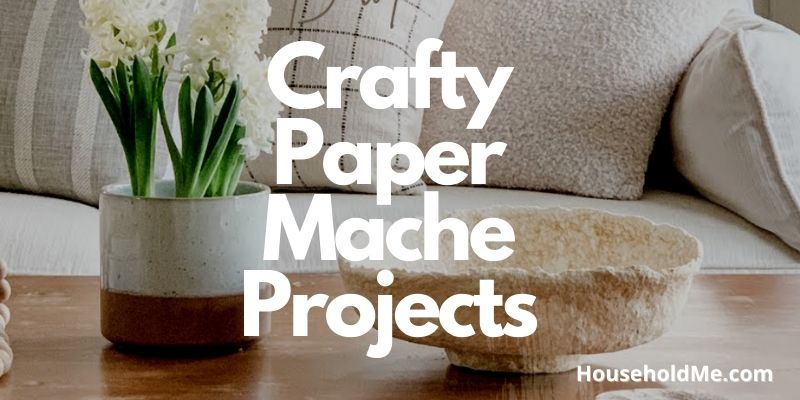When some people hear ‘paper mache’, they have vague memories of a very very messy art ‘project’ in elementary school during which they got white goo and strips of paper all over the place. Paper mache is a little like painting with watercolors. The end-result you got as a kid has the potential to be A LOT more professional looking than what you remember from your school art class. Paper mache can let you produce a number of different projects. After you have the basic technique mastered, it is a pretty straightforward process afterwards.

What Are The Different Types of Paper Mache?
You are probably familiar with the first type of paper mache. Strips of paper and a glue mixture are molded over a shape and let dry.
The method of paper mache involves producing a type of paper clay with small paper fibers and a glue mixture blended together well. This ‘pulp’ method is used by professionals for detailed sculptures and models. The paper strip layering method is better for DIY home projects since it involves less skill and causes less of a mess.
To make things easier, you can buy instant paper mache mix which only requires water. Below we will give you a recipe for making your own if you want to.
What Glue To Use?
If you do want to make your own paper mache glue mixture, you can simply use water and flour. These are cheap and easy to find ingredients. The downsides are that flour and water won’t dry clear. And this mixture can actually grow mold or rot over time since it’s basically food.
The best glue to use is, well, glue. White school glue, PVA glue, or wood glue all work well. Simply mix with water (usually fifty-fifty ratio).
What Paper To Use?
For most paper mache projects, newspaper is one of the best paper options. It’s widely available, and is easily torn without being too flimsy. It absorbs the glue mixture especially well. The downside is that it has to be painted over because the print will show through.
For more delicate projects, tissue paper can be used. Because it is so flimsy, you will need to layer more than newspaper. You can use colored paper so you do not have to paint once you are done. You can also use tissue paper as the final outer layer after a applying a base of newspaper.
Decorated paper like gift wrap, crepe paper, printed napkins, and other printed paper can also be used as a final layer that allows you to easily add patterns and color to your project.
If you chose to make pulp paper mache clay, toilet paper is a cheap alternative to newspaper.
Recipes for Paper Mache Paste
As mentioned above, there are several ready-made paper mache pastes available. However, making your own paste is often part of the fun! And it allows you to control the thickness and other characteristics which you are looking for. Kids especially enjoy making the goo.
Below are some recipes that have been tried and tested.
No-Cook Paste Recipe: This recipe is simply water and flour. Mix in a bowl with a whisk.
Cooked Paste Recipe: As the name suggests, this recipe involves heating the flour-water paste. It takes a little longer but the end result is smoother and stronger.
Resin Paper Mache Paste Recipe: Resin powder can be mixed with water to make a very strong, hard finish which will make your projects more durable.
How to Make Your Own Papier-Mache Base Forms and Molds
Now that you have some ideas on how to make the paper mache paste and the best paper to use, here are some suggestions on how to make various shapes. Some of the items below can be used for foundations while others can add specific detail.
Balloons
Balloons are great choices for paper mache. They can make round or elongated shapes depending on the balloon. They are also easy to remove when the project is dry. Simply pop and pull out.
Cardboard
Cardboard can be used to make any number of shapes. With some scissors and tape you can make pyramids, cones, and other irregular shapes. Some corrugated cardboard can even help you add texture to your project.
Chicken Wire
Chicken wire is one of the most flexible and versatile bases for paper mache. It’s easy to find on the market and it bends to almost any shape imaginable. You can connect several different components together very easily. It’s also very useful when making larger projects.
Newspaper
Not only is newspaper a great ingredient for paper mache, it can also be used to create irregular shapes. It can be crumpled into balls, twisted into arms or legs.
Shoeboxes
Shoeboxes make study bases for paper mache projects that incorporate storage or display.
Toilet Paper Rolls and Paper Towel Rolls
Paper towel, gift wrap, and toilet paper rolls make great bases for arms and legs.
Paper Mache Tips
Paper mache is a fun, hands-on, and MESSY craft! Even the most careful crafter will end up with glue on whatever surface they work on as well as their clothing. So make sure you cover your work space with something you don’t care about getting dirty. Doing the project outside is even better since you won’t have to breathe in glue fumes or worry about cleaning up a mess.
Some activities take several days to complete. Layers need to dry before more are applied. So be prepared to manage your kids’ expectations if they work with you. But since it can be a multi day project, you can stretch out the fun!
- Make sure your project is totally dry before painting and decorating.
- Tearing newspaper instead of cutting saves time and actually works better. Torn paper lays down more easily on a surface.
- To help your project last, apply an acrylic or varnish seal after painting. Spray on sealants are the easiest to use.
- Brown paper bags or towels as the final layer can give your project a natural look.
- Alternate the ‘grain’ of your paper strips as you work on your project. Using as many different directions as you can helps your project hold together better and adds strength.
- In a humid climate, use glue instead of flour and water.
- If your project is round, set it on a bowl or a large cub to keep it from rolling.
- If you have a shape inside of your project that you want to remove, make sure you have ample space at the bottom to remove it without damage. If it is a balloon, just pop the balloon and pull it through a hole you’ve left.
- Acrylic paints are one of the better paint choices for paper mache.
- Colored tissue paper can be added after the paper mache dries as texture and decoration.
Base materials, or what gives your paper mache project shape, can be made from several different materials. Balloons give you a general rounded shape. Aluminum foil can be molded to different shapes. Chicken wire is a good, lightweight base. Cardboard boxes can also be used for square or rectangular shapes. Crumpled up newspaper can also be taped with masking tape to hold various shapes.
If you are making paper mache pulp with newspaper, and decide to boil it, you may end up with ink on your pots. Soap doesn’t generally work well but paper towels and vegetable oil will loosen the ink so that soap and water can work.
Pinatas are great paper mache ideas. If you are making one, just remember to leave an opening through which you can add candy etc.
If you have any questions or comments, please add them below in the comment section. Similarly, please let us know if you spot any mistakes or omissions. Thanks!
